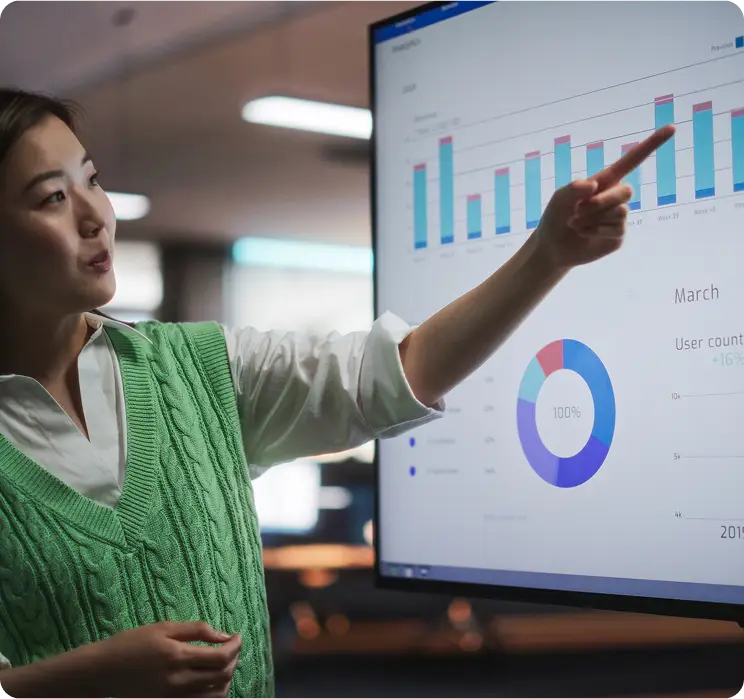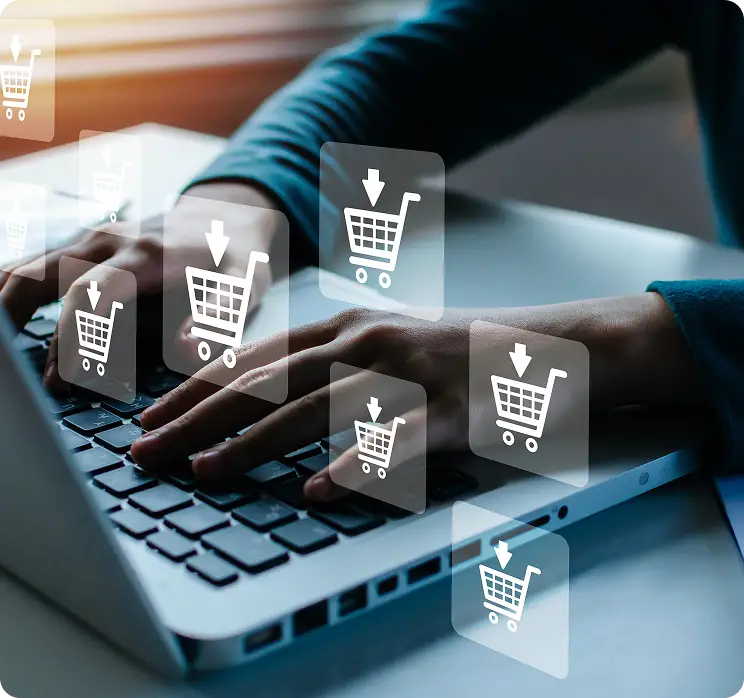Black Friday Cyber Monday 2025 Complete Guide
Global Trade Impact
The World Trade Organization projects a 0.2% decline in global trade this year, translating to roughly $840 billion in lost sales worldwide.
Thoughtful Spending
77% of shoppers plan to spend the same or more than last year, but they’re being more strategic about when and where they shop.
AI-Assisted Shopping
54% of shoppers plan to use AI tools during BFCM 2025, with 62% preferring AI assistants over salespeople for personalized recommendations.
Omnichannel Experience
77% of shoppers use three to four channels during their journey, while 23% use five or more, expecting consistency at every touchpoint.
Black Friday Cyber Monday 2025 demands a fresh approach if you want to succeed. In fact, retail is changing faster than ever this year. According to recent research from Klaviyo, winning brands aren't just offering deeper discounts. Instead, they're adapting to fundamental shifts in consumer behavior. Moreover, they're building strategies around personalization, loyalty, and seamless experiences.
Keep reading to learn how to prepare for BFCM 2025. Furthermore, discover how to make your campaigns a success during this critical shopping season.
The Global Retail Situation in 2025
The economic environment is creating significant headwinds for growth. Specifically, the World Trade Organization projects a 0.2% decline in global trade this year. This translates to roughly $840 billion in lost sales worldwide.
Rising Operational Challenges
Brands are dealing with new tariffs and rising operational costs. Additionally, unpredictable logistics make inventory management more complex than ever. Meanwhile, pricing decisions require careful consideration in this volatile environment.
Customer Acquisition Cost Pressures
At the same time, customer acquisition costs keep climbing. Getting new customers is more expensive than it's ever been. Consequently, retention and loyalty strategies become even more critical to profitability.
For marketing and eCommerce teams, this environment demands smarter planning. Moreover, it requires tighter execution. There's no room for scattered workflows when every campaign needs to work harder. Similarly, missed deadlines can be costly when driving results is paramount.
How Consumer Behavior Is Changing
Shoppers are feeling economic pressure. As a result, it's reshaping their purchasing decisions. Research shows that 81% say inflation affects their spending habits. Furthermore, about 35% are switching to more value-driven brands. In addition, 30% are shopping less frequently. Finally, 24% are specifically waiting for major sales events before making purchases.
Spending Remains Strong Despite Caution
The key takeaway is that people are still spending. In fact, 77% plan to spend as much or more than last year. However, they're being more thoughtful about when, where, and how they shop. Therefore, shoppers want value while also seeking brands they trust. Additionally, they desire experiences that fit their needs.
Because of this shift, brands need personalized messages across all channels. This takes close teamwork between email, creative, and eCommerce teams. Therefore, coordination is essential for success.
Why BFCM Still Matters
BFCM remains one of the most significant shopping events of the year. In fact, two out of five consumers still plan their purchases around BFCM. Consequently, it's a critical moment for retail and eCommerce brands.
The Old Playbook Doesn't Work Anymore
However, the old playbook doesn't work anymore in 2025. Success isn't about the biggest discounts or flashiest promotions. Instead, brands that stand out are moving from quick sales to building genuine relationships. Moreover, they're focusing on creating lasting customer connections.
Here's the difference: old BFCM campaigns saw shoppers as one-time deal hunters. Now, innovative brands see these shoppers as potential loyal customers. This means going beyond generic discounts to offer personalized journeys. Additionally, it involves rewarding loyal customers and providing consistent experiences wherever people connect with your brand.
The Economics of Retention
With CAC at an all-time high, retention delivers far more value. Converting a BFCM shopper into a repeat customer is crucial. Therefore, this approach provides significantly more value than capturing a single discounted sale.
What Klaviyo's Research Shows
To understand what actually works in this new environment, Klaviyo conducted comprehensive research. Specifically, they surveyed 7,000 consumers worldwide. One survey focused on BFCM shopping behaviors. Meanwhile, the other examined omnichannel shopping patterns across the whole customer journey.
Three Key Traits of Top-Performing Brands
The research found that top-performing brands in 2025 have three key traits. First, they personalize messages and offers based on customer data and behavior. This goes beyond using a first name in an email. Instead, it means understanding purchase history, browsing patterns, and preferences. As a result, they deliver relevant recommendations and timely offers.
Second, they build loyalty programs that reward repeat buyers. These programs create long-term relationships with customers. Furthermore, they give customers reasons to return beyond just discounts. Consequently, they build emotional connections and increase lifetime value.
Third, they create seamless experiences across all channels. This means businesses must ensure consistency across all touchpoints. Specifically, this includes email, SMS, web, social media, and in-store interactions.
However, these three elements only work if teams coordinate closely. If campaigns aren't in sync, customers notice immediately. Therefore, the whole strategy can fail without proper coordination.
Shopper Trends Heading Into BFCM 2025
Understanding specific consumer trends helps you build a winning strategy. Moreover, it ensures you meet shoppers where they are. Here are the key patterns shaping holiday shopping this year.
Younger Generations Start Shopping Earlier
While 40% of shoppers buy during the core BFCM period, 24% start even earlier. In some cases, they begin shopping months before. Notably, Gen Z leads this trend. Specifically, 30% begin their holiday shopping well before November.
Therefore, start your pre-BFCM campaigns in October to reach early shoppers. Plan your campaign calendar from October through January. Additionally, break each phase into clear tasks with assigned owners and deadlines.
The Holiday Season Now Extends Past December
About 9% of consumers make their first holiday purchase in January. Specifically, they shop during Boxing Day or New Year sales. Consequently, the holiday shopping season no longer ends in December. This means campaign planning needs to extend into the new year.
Teams need to see the whole extended season clearly. As a result, they can ensure nothing gets missed after the main BFCM rush. Furthermore, post-holiday sales are too important to ignore.
AI-Assisted Shopping Is Exploding
More than half of shoppers plan to use AI tools during BFCM 2025. Specifically, 54% will use them for deal comparisons, personalized gift ideas, and price checks. Even more striking, 62% would prefer using an AI assistant over speaking with a salesperson. Notably, they value AI tools that remember their preferences.
This means product data and pricing information need to be easily discoverable. Additionally, brand messaging should be structured for AI tools to surface accurately. Getting this right requires coordination between content teams, eCommerce teams, and marketing operations. Therefore, these technical preparations can't be overlooked.
Loyalty Still Matters
While consumers are spending more cautiously, they often remain loyal. Specifically, they stick with brands they trust and feel a connection with.
This makes loyalty programs more valuable than ever. Executing loyalty-focused campaigns means aligning multiple teams. Specifically, email teams, CRM specialists, and creative teams must work together. Furthermore, they need to focus on the same customer segments and messaging. As a result, they can achieve cohesive launches across all channels.
Email Still Leads, But Mobile Is Catching Up
Between 58% and 64% of shoppers still prefer email for brand communication. However, engagement is rising fast through other channels. Specifically, SMS, WhatsApp, push notifications, and live chat are growing rapidly.
Email remains the top channel overall. Nevertheless, brands must think mobile-first to meet customers where they are. This requires managing campaigns across multiple platforms simultaneously. Additionally, teams need clear visibility into what each team is launching and when.
Omnichannel Shopping Is Now the Norm
Research reveals that 77% of shoppers use three to four channels during their journey. Meanwhile, 23% use five or more. People move effortlessly between online and in-store experiences. Therefore, they expect consistency at every touchpoint.
The Challenge of Channel Management
Every interaction should feel connected throughout the customer journey. Your emails should match your SMS messages perfectly. Similarly, your website should reflect what customers see in-store. Furthermore, your social channels should show the same brand values consistently.
The problem is that most teams manage these channels separately. Email is on one platform, social on another. Meanwhile, SMS campaigns are tracked in spreadsheets. Without a clear view of how everything fits together, omnichannel marketing falls apart. Consequently, customer experience suffers.
Spending Is More Thoughtful
While 77% of shoppers plan to spend the same or more than last year, their approach has changed. Specifically, 65% are saving in advance and buying strategically during sales. Consumers are still spending actively. However, they expect personalized, relevant deals that feel worth their money.
This shows why smart segmentation matters more than ever. Additionally, targeted offers are crucial for success. Teams should organize their audience groups, creative options, and campaign plans carefully. As a result, they can deliver personalized experiences without confusion.
Execute Your Best BFCM Yet
Retail is more challenging this year without a doubt. However, there's still plenty of opportunity for brands that adapt quickly. Black Friday Cyber Monday 2025 will reward those who build authentic relationships. Moreover, it favors brands that offer genuine value and create personal experiences.
Strategy Meets Execution
Winning brands won't just have good strategies in place. Instead, they'll have the right systems to turn those strategies into action. Specifically, they'll execute well-coordinated, on-time campaigns across every channel.
That's where TaskOn makes a difference for your team. We help marketing and eCommerce teams plan smarter and collaborate better. Furthermore, we help them execute faster with precision. We'll help you build your complete campaign calendar with clear phases. Additionally, we assign owners and deadlines for accountability.
We coordinate across email, SMS, social, web, and in-store from one workspace. Moreover, we organize customer segments, creative assets, and campaign workflows in one place. We keep your entire team aligned on what's launching when across all channels. Finally, we monitor progress in real time to ensure no tasks are overlooked.
When all your channels need to work together seamlessly, TaskOn helps. Moreover, when every deadline counts, we keep your whole BFCM operation on track.
Ready to Streamline Your BFCM 2025 Planning?
Book a call now to see how we can help your eCommerce team execute winning campaigns without the chaos.
Book Your Call Now

